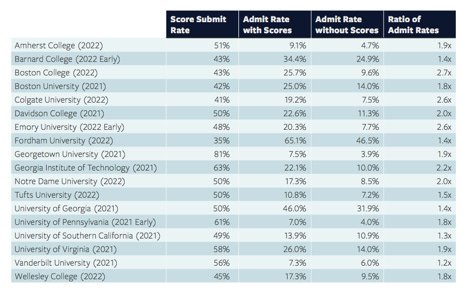Contra Yglesias on test-optional admission
Matt Yglesias argues today that:
“the schools leading the push toward de-testing are not making some kind of blunder, they are trying to get away with something. I’m fond of Talleyrand’s old quip ‘it’s worse than a crime, it’s a mistake,’ but in this case, it’s a crime. SAT scores make it inconveniently easy to demonstrate anti-Asian discrimination in college admissions, so the industry is moving to burn the evidence.”
I think he’s wrong. Colleges with test-optional admissions policies aren’t committing crimes or blunders. To continue with the metaphors, they’re having their cake and eating it too. They get to look like they’re very concerned about the links among race, income, and test scores, while still letting in whichever kids they want.
Test scores are like credit scores
Colleges’ revealed preference, evident in their action, is to let in more applicants who submit test scores.
I’ve highlighted this table from Compass test prep before, but it is just so telling. Many colleges let in score-submitters at around double the rate of kids who don’t submit scores. Sorry it’s so tiny; Squarespace’s blogging functionality is bad.
Test scores are like a credit rating. Would you lend money to someone whose credit score you don’t know? Colleges don’t want to make risky bets either. Test scores are un-fiddle-able, immune to grade inflation, and a strong predictor of college success. Colleges care about that success because if you flunk out, the tuition checks stop, and you drag down their four-year-graduation rates and thus their US News ranking.
Juicing the denominator
There’s a darker motive that might prompt colleges to go test-optional: to attract more low-scoring applicants, reject them, and so have a lower acceptance rate. Peter Arcidiacono, a Duke economist, argues that Harvard does exactly that with Black applicants.
Prestige-optimizing, not Asian-minimizing
Yglesias is overestimating how badly colleges want to keep out Asian-Americans. For most colleges, affirmative action is not the top priority; money and prestige are. They pursue affirmative-action goals to the extent that those goals do not conflict with money and prestige.
Here’s some evidence, which you’ve heard here before. Harvard gives Black applicants a boost. When an applicant is both Black and poor, the coefficient on the interaction term is negative. Harvard dials down the affirmative-action benefit for poor Black applicants, relative to richer ones. One result is that most Black students at Harvard are not the descendants of American slaves.
Then why does Harvard have affirmative-action policies? I think it wants a Benetton-ad ethnic distribution because it thinks that is prestige-maximizing, or at least criticism-minimizing, and is also engaged in a little willful self-delusion. Epistemic status for this paragraph: informed conjecture.
Also, crucially, not all colleges are Harvard. Many colleges welcome high test scores, regardless of the test taker’s ethnicity, because they want to climb up the US News rankings. Lots of these are (ostensibly) test-optional. Yglesias’s thesis doesn’t make sense for them.
What about the test-blind colleges?
Yglesias fails to distinguish between test-blind and test-optional schools. The former won’t look at your scores even if you submit them. The latter, as we’ve just discussed, very much want to see your scores, especially nice high ones.
I’m lobbing stones from my glass house, though, because test-blind colleges are inconvenient for my model. I assert colleges choose test-optional policies because those policies get the Twitter commentariat off their backs, not because of their ideological commitments. What about the test-blind ones?
Some test-blind colleges probably are acting out their ideological commitments. Others are probably trying to drum up customers. We can identify a few buckets of test-blind schools and consider their reasons.
The most prominent test-blind colleges are state-funded colleges in California, like the UCs, CSUs, Cal Polys, San Francisco State, etc. They probably are test-blind because of ideological commitments. They can afford to be, even though test-blind policies probably decrease their revenue and increase their borrowing costs, because Sacramento ultimately foots the bill.
Some other states’ public colleges are also test-blind, though the flagship campuses generally aren’t. There are examples in Idaho, Minnesota, New Hampshire, New Jersey, New York, Pennsylvania, and Washington. These colleges can afford to ignore applicants’ test scores because they also have that taxpayer backstop.
Once we remove public colleges in California and those states, there are just under 50 test-blind colleges in the US. How and why do these private colleges do it?
Some of these are acting on ideological commitments too. Pitzer, Reed, Wells, and Catholic probably fall in this category. They can maybe afford this luxury either because of their endowments, existing prestige (which they risk eroding), or because they piggyback on some other institution. For example, Pomona and Claremont McKenna probably pull Pitzer along, and CUA probably gets money from other Catholic institutions.
Another category contains colleges scrounging for kids. I’m not going to give examples because that’s a little mean. They’re probably trying to attract applicants, any applicants, by reducing the application burden.
The final category contains just Caltech, and I don’t really understand their reasons. We’ll see what they do in 2025, when their test-blind trial ends. I guess their calculus requirement is enough of a filter.
What does the changing test landscape mean for your kid? The short answer is to take a standardized test, at least twice. For a longer answer, you could book a one-on-one session here. I look forward to working with your family!

